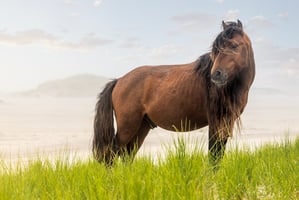The holiday season is a time for giving, and finding the perfect gift for your loved ones can feel...
Sable Island: Wild and Untamed Beauty
When I released my photos and video from Sable Island, the response was overwhelming. Not just for the raw beauty of the images, but for the questions they raised: “Where is Sable Island?” “Why are there wild horses there?” “Do they get fed or cared for?” For many, the existence of this remote island—and its untamed equine inhabitants—was a complete mystery.
This curiosity is part of what makes Sable Island so special. Situated 190 miles off the coast of Nova Scotia, this crescent-shaped sandbar is as wild as it gets. It’s a place where horses roam free, untouched by human hands, surviving on the sparse grasses that grow on the windswept dunes. But it’s also a place that challenges our perceptions of what it means for wildlife to be truly wild.
The Untouched Beauty of Sable Island
Sable Island is unlike anywhere I’ve ever been. With no cell service, no permanent human residents, and a landscape shaped by the relentless forces of wind and sea, it’s a place that feels entirely removed from the modern world. The wild horses, descendants of animals brought there hundreds of years ago, are the island’s most famous inhabitants. Watching them graze, gallop, and survive in this raw, unforgiving environment is a humbling experience.
The island is managed by Parks Canada, and its philosophy is one of non-intervention. The horses are not fed, cared for when sick, or given shelter. They live and die entirely on their own terms, embodying the purest definition of “wild.”
The Questions and Controversies
For many, this hands-off approach sparks questions—and even controversy. Some wonder why the Canadian government allows the horses to remain in conditions that lead to deaths from harsh winters or limited resources. Others see the lack of intervention as neglect or cruelty.
But is it really cruelty to let wildlife remain wild? Many species live in harsh, challenging environments, and humans can’t intervene in every case. The Sable Island horses are unique in that they’ve been allowed to exist without human interference for centuries. To remove them from the island would be to strip away the very essence of what makes them remarkable.
Personally, I believe the horses would choose the freedom of the island, challenges and all, over a life confined to enclosures elsewhere. But these are complicated questions without easy answers, and the beauty of Sable Island is intertwined with these complexities.
Life on the Island: A Photographer’s Perspective
.jpg?width=403&height=268&name=unnamed%20(1).jpg) During my time on Sable Island, I lived in the park’s accommodations—a setup reminiscent of college dorms. With no cell service and only the essentials, it was a true off-the-grid experience. Each day, I set out to capture the island’s wildness: the sweeping dunes, the changing weather, and, of course, the horses.
During my time on Sable Island, I lived in the park’s accommodations—a setup reminiscent of college dorms. With no cell service and only the essentials, it was a true off-the-grid experience. Each day, I set out to capture the island’s wildness: the sweeping dunes, the changing weather, and, of course, the horses.
The island’s solitude is profound. There’s a silence that’s rare in today’s world, broken only by the wind or the sound of hooves. It’s in this stillness that the spirit of Sable Island reveals itself, and it’s why this place, and these horses, have stayed with me long after I left.
Closing Thoughts
Sable Island is a place of contradictions. Its beauty is raw and untamed, but its very existence raises questions about what it means to live wild. For me, the horses are a testament to resilience and freedom, and their story is one that deserves to be told, celebrated, and protected.
I hope my photos and video spark your curiosity about this remarkable island. It’s a place like no other, and one I feel privileged to have experienced.



